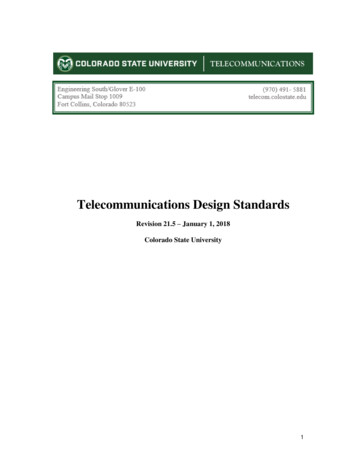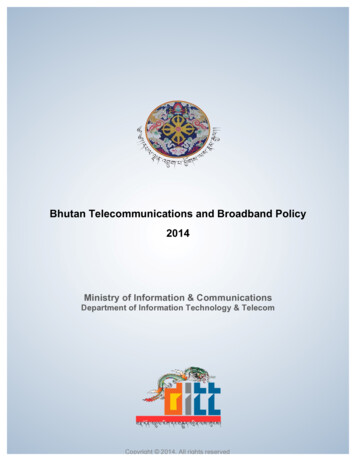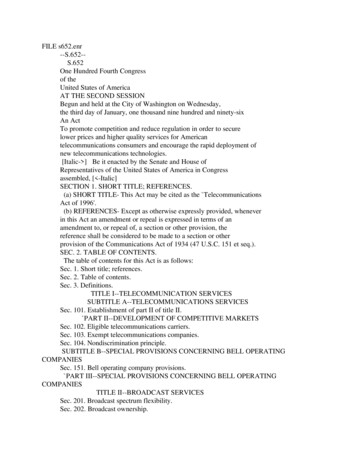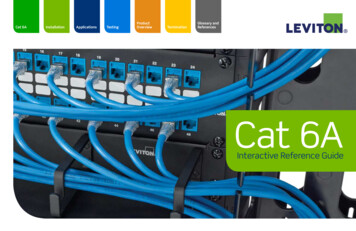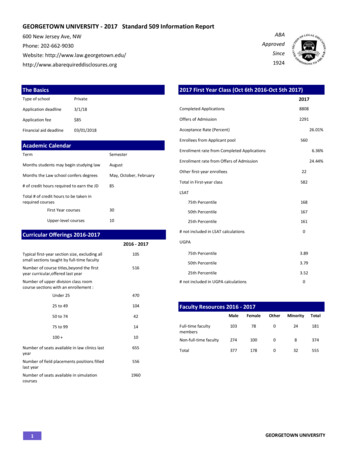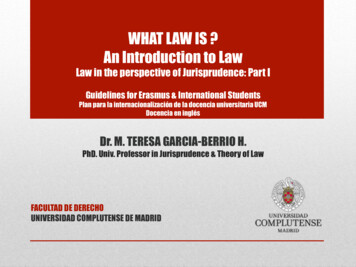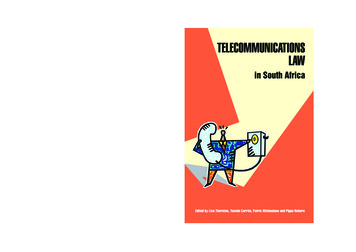
Transcription
This book, Telecommunications Law in South Africa, hasbeen written to provide an overview of the policy, lawand regulation of telecommunications in South Africa.It includes chapters on the important regulatory topics,including Licensing, Interconnection and Facilities Leasing,Pricing and Universal Service. It also includes chapters onThe Regulators and Convergence, as well as an Overviewand chapters on Economics and Technologies, authoredby recognised experts in those areas. Separate chapterson the Electronic Communications and Transactions Actand The Regulation of the Interception of Communicationsand Provision of Communication Related Information Actare also included.This book will prove invaluable to legal practitioners inthe field, as well as policy makers, legislators, regulators,journalists, academics, researchers, consultants, students,and telecommunications companies.TELECOMMUNICATIONS LAW in South AfricaThe regulation of telecommunications really only began inSouth Africa after the historic first democratic election in1994. Many developments in the policy, law and regulationhave taken place since then.TELECOMMUNICATIONSLAWin South AfricaEdited by Lisa Thornton, Yasmin Carrim, Patric Mtshaulana and Pippa Reburn
00 Contents!!5/10/0612:06 PMPage 1TELECOMMUNICATIONSLAWin South AfricaEdited byLisa Thornton, Yasmin Carrim,Patric Mtshaulana and Pippa ReyburnA Lisa Thornton Incempowerment initiativeFunded in part by the ACACIA Programme of theInternational Development Research Centre (IDRC), Canada
00 Contents!!5/10/0612:06 PMPage 22First published in 2006 bySTE Publishers4th Floor Sunnyside Ridge,Sunnyside Office Park,32 Princess of Wales Terrace,Parktown 2143Johannesburg, South Africa April 2006 Lisa Thornton IncISBN 1-919855-76-9Design:Mad Cow StudioIndex:Mirie Van RooyenIllustrations:Courtesy APC (Association for Progressive Communicators)Printed and bound in South Africa by Interpak BooksAll rights reserved. Without limiting the rights under copyright reserved above, no part of this publicationmay be reproduced, stored in or introduced into a retrieval system, or transmitted, in any form or by anymeans (electronic, mechanical, photocopying, recording or otherwise) without prior written permission ofboth the copyright holder and the publishers of the book.This book is sold subject to the condition that it shall not, by way of trade or otherwise, be lent, re-sold,hired out or otherwise circulated without the publisher’s prior consent in any form of binding or cover otherthan that in which it is published and without a similar condition being imposed on the subsequent purchaser.
00 Contents!!5/10/0612:06 PMPage 33CONTENTSPreface – LISA THORNTONNote from Funders – HELOISE EMDONCHAPTER 1Telecommunications Law – An Overview – LISA THORNTON16-48Introduction1 What is Telecommunications?2 Why Telecommunications is Specially Regulated3 How Telecommunications is Regulated4 The Regulation of Telecommunications in South Africa4.1 Constitutional Framework4.2 National Policy4.3 International Law4.4 National LegislationConclusion17171819202022283047CHAPTER 2Telecommunications Technologies – MIKE BRIERLEY50-81Introduction1 What is Telecommunications?2 Where did Telecommunications start?3 Digital versus Analogue Communications4 Circuit versus Packet Technologies5 Speed of Transmission5.1 It’s all about speed!5.2 How has this been possible?6 Telecommunications Technologies6.1 Multiplexing Mechanisms6.2 Wireless Technologies6.3 Television and Satellite Technologies6.4 Legacy Wireline (Copper) Technologies7 The Internet7.1 Internet Protocols (IP and TCP/IP)515152525354545555555760616262
00 Contents!!5/10/0612:06 PMPage 447.2 IP Addressing7.3 Broadband TechnologiesConclusionGlossary of Terms63656667CHAPTER 3The Economics of Telecommunications and itsRegulation – JAMES HODGE AND KEITH WEEKS82-981 The Defining Economic Features of Telecommunications1.1 Significant Economies of Scale1.2 Network Externalities1.3 Compatibility and Standards1.4 Complementarities in Demand1.5 Switching Costs2 The Economics of Telecommunication Regulation2.1 Some Aspects of ex-ante Regulation2.2 Some Aspects of ex-post Regulation838385878888899194CHAPTER 4The Telecommunications Regulators – LERATO MOKGOSI100-130Introduction1011 Comparative Analysis1012 Legislative Framework of the Regulators1022.1 Constitution of the Republic of South Africa1022.2 Regulatory bodies established in terms of the Telecommunications Act1032.3 Powers of the Minister in terms of Telecommunications Act1042.4 Powers of the DoC in terms of Telecommunications Act1052.5 Competition Act, 89 of 19981062.6 Independent Communications Authority of South Africa Act, 13of 2000 (Icasa Act)1073 International Instruments and Organisations1073.1 International Telecommunications Union (ITU) and the African Green Paper 1073.2 World Trade Organisation (WTO)1083.3 Telecommunications Regulators’ Association of Southern Africa (Trasa)1094 Icasa1104.1 Formulation and objects1104.2 Powers and duties of Icasa1114.3 Structure1124.4 Challenges facing Icasa as a merged Regulator1124.5 Independence of the Regulator113
00 Contents!!5/10/0612:06 PMPage 554.6 Staffing of the Regulator5 Competition Regulation5.1 Telecommunications Regulation and Competition5.2 Relationship between the Competition Commission and Icasa5.3 Objectives of Regulation of Competition in Telecommunications5.4 Sector-specific Regulation versus general Competition RegulationConclusion122123123124125127129CHAPTER 5Licensing – SEENA YACOOB AND KAMESHNI PILLAY132-171Introduction1 Licensing1.1 What is a Licence?1.2 What are the Objectives of Licensing?2 Telecommunication Licensing in South Africa2.1 International Obligations2.2 The Legislative Framework in South Africa – An Introduction3 Telecommunication Service Licences: Chapter V of theTelecommunications Act3.1 The Legislative Requirement 1373.2 Categories of Telecommunication Service Licences3.3 Applications and Consideration of Applications3.4 Ownership and Control Restrictions3.5 Amendment of Licences3.6 Renewal of Telecommunication Service Licences3.7 Transfer of Licences3.8 Public Switched Telecommunication Services (PSTS)3.9 Mobile Cellular Telecommunication Services3.10 Value Added Network Services (Vans)3.11 Private Telecommunication Network Services3.12 Under-serviced Area Licences3.13 Sentech3.14 Global Mobile Personal Communications by Satellite Services3.15 Mobile Data Services4 Frequency Licensing: Chapter IV of the Telecommunications Act4.1 Frequency Use Licences4.2 Certificates of Proficiency4.3 Authority to Operate4.4 Guidelines for Licences4.5 Procedure for Application of Licences4.6 Radio frequency spectrum licences in the 1800 MHz frequency bandand third Generation radio frequency spectrum licences5 Equipment Licensing: Chapter VI of the Telecommunications 1156159160161163164164165166166166166167168
00 Contents!!5/10/0612:06 PMPage 665.1 Equipment Type Approval5.2 Equipment Standards5.3 Registration as a Supplier6 Licence FeesConclusion168168169169171CHAPTER 6Interconnection and Facilities Leasing –JOY MARIE LAWRENCEIntroduction1 What are Interconnection and Facilities Leasing and why are they Important?2 Should Interconnection and Facilities Leasing be regulated?3 How should Interconnection and Facilities Leasing be regulated?4 The Regulatory Framework of Interconnection and Facilities Leasingin South Africa4.1 Section 43(1): Interconnection4.2 Facilities Leasing - Section 44(1)-(4)4.3 Agreements to be lodged with Authority – Sections 43(2) and 44(4)4.4 Authority to prescribe Guidelines - Sections 43(3), 44(5) and 44(6)4.5 Provision of facilities other than from Telkom – Section 44(7)4.6 Request for Facilities Leasing or to interconnect – Section 43(4)4.7 Authority may impose terms and conditions – Section 43(5)(b)4.8 Enforceability of terms and conditions – Section 43(6)4.9 Negotiations not precluded if licence not awarded as yet – Section 43(8)4.10 Period of Interconnection Agreement – Section 43(10)4.11 Interconnection rates to be made public – Section 43(11)5 Interconnection and Facilities Leasing Guidelines5.1 Background5.2 Analysis of Interconnection Guidelines and SupplementaryInterconnection Guidelines5.3 Analysis of Facilities Leasing Guidelines and Supplementary FacilitiesLeasing 2182182183184184184185185185185186194197CHAPTER 7Telecommunications Pricing Regulation – LISA THORNTONAND JAMES HODGEIntroduction1 Why Pricing Regulation?2 The Telecommunications Act provisions regarding pricing2.1 Determining Fees and Charges for Telecommunication Service –200-214201201201
00 Contents!!5/10/0612:06 PMPage 77The Rate Regime2.2 Accounts and Records to be kept by Licensees3 The Regulation of PSTS Retail Pricing3.1 The Ministerial Rate Regime3.2 The First Icasa Rate Regime3.3 The Rate Regime Dispute3.4 The Filing of Tariffs4 The Regulation of MCTS Retail Pricing4.1 The Rate Regime4.2 Rate Regime Reviews4.3 The Filing of Tariffs5 Regulatory Accounts5.1 PSTS Regulatory Accounts5.2 MCTS Regulatory 1211212213214CHAPTER 8Universal Service and Universal Access – MANDLA MSIMANG216-245Introduction1 What is Universal Service and Universal Access and Why regulate for it?2 The Universal Service and Universal Access Landscape2.1 ITU: ‘The Missing Link’2.2 WTO: South Africa’s International Commitments2.3 From the White Paper to the Telecommunications Act3 Role and Relevance of the USA3.1 Establishment and functions3.2 Key Policy Projects of the USA4 Role and Relevance of the USF4.1 Administration of the USF4.2 Contributions to the USF4.3 Application of USF money5 Restructuring of the USA6 Telkom's exclusivity and Universal Service6.1 Background6.2 Rollout Obligations7 Mobile Cellular Telecommunications Service Operators' role in ProvidingUniversal Service and Universal Access7.1 MTN and Vodacom Community Service Obligations7.2 Cell C (New Entrant) CSOs7.3 MCTS Commercial Rollout7.4 The Role and Relevance of Prepaid Technology7.5 MCTS Joint Economic Development Agreements8 Telecommunications Amendment Act: Beyond PSTS and MCTS, a 231232234234235236237237
00 Contents!!5/10/0612:06 PMPage 88in thinking about Universal Access8.1 Background8.2 E-Rate8.3 Issuing of 1800 MHz and 3G Spectrum8.4 Sentech: Rolling out Multimedia8.5 Under-serviced Area Licences9 Gender and Universal Service and Universal AccessConclusion238238239239240241243244CHAPTER 9Convergence – OUPA SUPING, KERRON EDMUNSON ANDANTON ALBERTS246-260Introduction1 What is Convergence?1.1 Definitions1.2 The Drivers of Convergence1.3 The South African Context2 Policy and Regulatory Issues2.1 What is Policy?2.2 The South African Policy landscape2.3 Possible Policy objectives2.4 Policy and legislation to date3 Current Legislative Framework affected by Convergence3.1 Telecommunications3.2 Broadcasting4 Possible outcomes and/or consequences of Convergence5 International 55256257259260CHAPTER 10The Electronic Communications and Transactions Act –SHUMANI GEREDA262-294Introduction1 International Regulation of Electronic Communications1.1 The Model Law1.2 The Model Law on e-Signatures1.3 The Organisation for Economic Co-operation and Development (OECD)1.4 The EU Directives on e-Commerce2 The ECT Act2.1 National e-Strategy263264264265265266268268
00 Contents!!5/10/0612:06 PMPage 992.2 Electronic Transactions Policy2.3 Legal recognition of data messages2.4 E-Government Services2.5 Cryptography Providers2.6 Authentication Service Providers2.7 Consumer Protection2.8 Protection of personal information2.9 Limitation of service provider liability2.10 Critical Databases2.11 Domain Name Authority and Administration2.12 Cyber Inspectors2.13 Cyber Crime3 Some of the criticisms levelled against the ECT Act4 Other relevant South African Legislation4.1 Privacy and Data protection4.2 The Electronic Communications Security (Pty) Ltd Act5 Comparative study of selected foreign jurisdictions5.1 Australia5.2 The United Kingdom (UK)5.3 The United States of America5.4 Canada6 Comparison and analysis of the International Instruments6.1 The Model Law and the ECT Act6.2 The Model Law on e-Signatures and the ECT Act6.3 The EU Directive on e-Commerce and the ECT Act6.4 The US UETA and the ECT Act6.5 The e-Sign Act and the ECT PTER 11The Regulation of the Interception of Communications andProvision of Communication Related Information Act –NAZREEN BAWA296-332Introduction1 Legislative and Policy Development1.1 South African Law Reform Commission1.2 Parliamentary Process2 Constitutional Framework2.1 Rights2.2 The Right to Privacy2.3 The Right to Freedom of Expression2.4 The Limitation of a Right3 The Scope of the Application of ROICA297299299300300301301304306307
00 Contents!!5/10/0612:06 PMPage 10103.1 Objectives3.2 Interception3.3 Monitoring4 Prohibition on Interception and Monitoring4.1 General Prohibition4.2 Exemptions under ROICA5 Directions of ROICA5.1 Issuing of Directions5.2 Written and Oral Applications5.3 Communication-related Directions5.4 Entry Warrants5.5 Execution of Directions5.6 Fair Procedures6 Obligations on the Industry6.1 Generally6.2 Costs6.3 Data Retention6.4 Cellular Phones and SIM-cardsConclusionPostscriptList of AcronymsProfile of Authors and 25327330331332
01 TelecLaw5/10/0612:52 PMPage 11
01 TelecLaw5/10/0612:52 PMPage 1212Prefacehis book came out of two ideas – to write a reference book ontelecommunications law and to empower a new generation of lawyers withskills and knowledge in telecommunications law.The project was conceived and developed in 2002, with valuable input from anumber of different persons and organisations. It was decided that several younglawyers would be chosen on open application to contribute chapters to a book ontelecommunications law. This was done in early 2003. The authors developed abook outline, chapter outlines and drafted chapters, under the guidance of a teamof advisors. A number of workshops were held with the authors, both onsubstantive areas of telecommunications law and on research and writing skills.This book is not intended to be the definitive text on South Africantelecommunications law. We do hope however that we have succeeded inproducing a much-needed reference book. We also hope that we have contributedto the development of telecommunications lawyers.We also hope that this project will continue and grow. We would like to publishthe contents of the book on a website and provide access to resource materials. Wealso hope to provide chapter updates and new chapters, as appropriate. Wewelcome any suggestions in this regard. We welcome also any comments on thecontents of this book and suggestions for improvement.Finally, I would like to take this opportunity to thank some of those peoplewithout whom this project could not have happened.T The other members of the advisory team, Advocate Patric Mtshaulana, MsYasmin Carrim and Ms Pippa Reyburn. The project accountant, Ms Nerine Butler of Douglas & Velcich CharteredAccountants, with special thanks to Ms Butler for invaluable administrativeand editing assistance as well.
01 TelecLaw5/10/0612:52 PMPage 13Preface Ms Kim Morgan, for helping to administer the project. The International Development Research Centre (IDRC), with special thanksfor encouragement, support and advice from Ms Heloise Emdon. Those who presented at workshops, Ms Carrim, Mr Mike Brierley, Mr BrianAdams and Mr John Linnegar. Thanks also to Mobile Telephone Networks(Pty) Ltd and MTN Network Solutions (Pty) Ltd for hosting such workshops. The Hivemind Network hosted by the Future Foundation Management CCfor hosting a list serve on behalf of the project, with a special thanks to MrAnthony Brooks. To Mr Mike Brierley for his invaluable chapter on telecommunicationstechnology. To Mr James Hodge and Mr Keith Weeks for their invaluable chapter ontelecommunications economics. To Mr John Linnegar and Ms Kerron Edmunson for editing assistance. The publishers, STE Publishers (Pty) Ltd.Lastly, I would like to thank the authors for their participation in the project.I wish them all well in their careers.Lisa ThorntonDirector, Lisa Thornton Inc13
01 TelecLaw5/10/0612:52 PMPage 1414Note from Fundersnowledge is information at work, and information can only work if there arenetworks! Networks that criss-cross and intertwine the globe have becomethe new arteries to our new lifeblood of information.It is these networks that make possible multi-trillion dollar transactions hourly. Ata fraction of the cost of an international call, a Voice over Internet (VoIP) call canconnect a migrant student halfway around the globe to her rural parents backhome in Africa.These networks also make possible an emergency call to the local hospital, or anemail containing an .mpeg file showing the extent of crop disease in the EasternCape to an agricultural research centre based anywhere in the world.It is networks that enable a German tourist to download images of a townshipB&B in the Cape Flats, or the extraction from a huge relational database of an SMSback to a rural HIV-positive patient to remind him of a follow-up visit to the ruralclinic, and his latest CD count.These are what dreams are made of! We see a networked world that allows thedeveloped and the developing worlds to engage. We see ICTs bringingempowerment. But we also see very poor levels of access to information andcommunication technologies and to telecommunications in developingcommunities. While the ITU reveals in its April 2004 statistics that 6% of allAfricans have access to cellular telephony, it also points out that only one person in50 on the continent is “wired” to the Internet.Our work with development partners who do research into the interfacebetween developing communities and ICTs reveals that in Africa, as in otherregions, communities have to overcome high barriers of entry to participate in theICT revolution. Telecommunications access is one of those barriers. Access to theinformation age equates to access to dial tone. That access also translates toaffordability.K
01 TelecLaw5/10/0612:52 PMPage 15Note from FundersThis book interrogates the technologies and the economics oftelecommunications, the international and national policy contexts, the regulatorand its role in broadening participation in the telecommunications sector. It goesfurther to bring us up to date on matters of convergence, electroniccommunications law and the state of play with interception and monitoringlegislation in South Africa.The IDRC is excited about the innovative approach Lisa Thornton’s projectteam has taken by creating the opportunities for young lawyers, technologists andresearchers to learn by doing the research for this book.We also acknowledge that in many respects the liberalisation model that SouthAfrica chose in telecommunications has been emulated by other African countries.We believe that a thorough and thoughtful analytical work of this nature wouldhelp not only South Africans but other countries to learn from the lessons ofexperience and of the context here appraised on their journey towards the NetworkEconomy.Heloise EmdonSenior Programme Officer: Acacia and Connectivity Africa, International DevelopmentResearch Centre (IDRC)15
01 TelecLaw5/10/0612:52 PMPage 1616Telecommunications Law –an Overview1Lisa Thornton1The author would like to thank Sanette Nel and Lee Mendelsohn for reviewing parts of previous drafts of this chapter and YasminCarrim, Elize van der Walt, Tanya Scott, Mandla Msimang, Keith Weeks and Devan Naidoo for providing valuable information.
01 TelecLaw5/10/0612:52 PMPage 17Lisa ThorntonIntroductionnternationally, the International Telecommunication Union is in place toregulate telecommunications. Domestically, in South Africa, there is a myriadlegislation – including telecommunications-specific legislation, theTelecommunications Act, 103 of 1996 – and a specialist regulator has beenestablished to regulate telecommunications: the Independent CommunicationsAuthority of South Africa (Icasa). Why is this so? What is it abouttelecommunications that requires such a high degree of regulation?This chapter begins by addressing these questions, by looking at the question‘what is telecommunications?’ and then by identifying reasons why the industry isso highly regulated. The chapter then looks generally at the way in whichtelecommunications is regulated and finally specifically at how it is regulated inSouth Africa.The chapter is intended to provide a big-picture overview of howtelecommunications is regulated in South Africa. More detail will follow in thesucceeding chapters, which will deal with specific issues, such as licensing,interconnection, pricing and universal service.Primarily, the following are discussed in this chapter: the constitutionalframework; national policy; international law; and national legislation, includingthe Telecommunications Act, the Independent Communications Authority ofSouth Africa Act, 13 of 2000 (the Icasa Act), the Competition Act, 89 of 1998, theElectronic Communications and Transactions Act, 25 of 2002 (the ECT Act) andthe Regulation of Interception of Communications and Provision ofCommunication-Related Information Act, 70 of 2002 (later in this chapter, this Actwill be referred to as ‘the Interception Act’). The chapter concludes with a fewsuggestions for improving the regulatory framework for telecommunications inSouth Africa.I1. WHAT IS TELECOMMUNICATIONS?‘Telecommunications’ is defined in Newton’s Telecom Dictionary as:The art and science of ‘communicating’ over a distance by telephone,telegraph and radio. The transmission, reception and the switching of signals, suchas electrical or optical, by wire, fibre, or electromagnetic (ie through-the-air) means.2The definition holds two concepts. The first is the act of communicating, inother words, imparting and receiving information. The second is the means ofcommunicating, in other words, communications infrastructure.The Constitution of the Republic of South Africa Act, 108 of 1996 guaranteesthe right to communicate. Section 16(1) states:Everyone has the right to freedom of expression, which includes –(b) freedom to receive or impart information or ideas .323H Newton Newton’s Telecom Dictionary 18 ed (2002) 733.s 16(1)(b) of the Constitution.17
01 TelecLaw185/10/0612:52 PMPage 18Telecommunications LawThe right to freedom of expression has been interpreted to mean not only theright to speak and the right to hear speech but also the right to have access to themeans by which to communicate.4The Telecommunications Act, which provides for the primary regulation of thetelecommunications industry in South Africa, defines telecommunications morenarrowly as the means by which to communicate, as follows:the emission, transmission or reception of a signal from one point to another bymeans of electricity, magnetism, radio or other electromagnetic waves, or anyother agency of a like nature, whether with or without the aid of tangibleconductors.52. WHY TELECOMMUNICATIONS IS SPECIALLY REGULATEDThere is nothing obvious in definitions or the concept of telecommunications thattells us why it is so specially and highly regulated. So why is this the case?Traditionally, the answer to why telecommunications has been so regulated hasbeen threefold. First, telecommunications was seen in the same light as otherpublic utilities, such as water and electricity. Governments generally believed thatit was their duty to ensure universal access to such services by providing theservices themselves.6 In the White Paper on Telecommunications Policy, 1996, theSouth African Government articulated the importance of communications in thedevelopment of South Africa.7 Although history has proven that creating andprotecting government-owned monopolies may not be the best way to ensureuniversal service, the development and implementation of effective policies to spuruniversal service will continue to prove to be key in regulating telecommunicationsfor the future.Secondly, governments historically thought about telecommunications as a‘natural monopoly’.9 Therefore, most governments protected a monopoly supplierof services by not allowing competitors to be licensed.10 This economic model,however, is increasingly becoming inadequate for a number of reasons, not least ofwhich is the advancement of technology.11 Today, regulatory policy and law4See TS Masiyiwa Holdings (Pvt) Ltd and Another v Minister of Information, Posts and Telecommunications 1998 (2) SA 755 (ZS) at767–8; Retrofit (Pvt) Ltd v Posts and Telecommunications Corporation (Attorney-General of Zimbabwe Intervening) 1996 (1) SA 847 (ZS)at 858–865. Although the cases cited are Zimbabwean, the Zimbabwean Constitution is substantially similar to the South AfricanConstitution in regard to the right to freedom of expression.5s 1 of the Telecommunications Act.6H Intven (ed) Telecommunications Regulation Handbook Module 1 – Overview of Telecommunications Regulation (2000) 1–2.7The White Paper on Telecommunications Policy, GN 291 of 1996 in GG 16995 dated 13 March 1996, chapter 1. See also The NewPartnership for Africa’s Development, October 2001, para V.B.ii.8Minister of Communications, Dr I Matsepe-Casaburri, Address at the National Colloquium on Convergence Policy, 15 July 2003,docweb.pwv.gov.za/Convergence/speech.html (‘In bridging the digital divide through the utilization of the new technologies andexpedited by convergence, our perspective on information and communications technology should be to continue to promote universalservice, to ensure access for disadvantaged people and ensure that they participate as active producers in the information society, notmerely as passive recipients of an imported and distant content.’).9CT Foreman (ed) The Telecommunications Debate in Regulating for the Future – The Creative Balance (1991) 176.10In terms of s 36(3) of the Telecommunications Act, Telkom SA Limited was granted an exclusive licence to provide certain publicswitched telecommunication services for a period to be specified in its licence. The period specified was five years (para 3, LicenceIssued to Telkom SA Limited to Provide Telecommunication Services under s 36 of the Telecommunications Act, 1996, GN 768 of 1997GG 17984 dated 7 May 1997). However, despite the period of exclusivity having ended on 7 May 2002, Telkom enjoys a de factomonopoly because, as of June 2004, a competitor has not been issued a licence as required by ss 32A(1) and 32B of theTelecommunications Act.11Foreman (note 9 above) 175.
01 TelecLaw5/10/0612:52 PMPage 19Lisa Thorntonregarding telecommunications are more focused on controlling monopolisticbehaviour than on protecting monopolies.12 The regulation of interconnection andpricing (in addition to regulating for universal service) will be critical in thetransition from a monopoly to a competitive market.13Thirdly, it is important to regulate telecommunications specially to the extentthat a valuable national resource is involved, namely the radio frequency spectrum.Without the exercise of control over how the spectrum is used and who gets to useit, anarchy might prevail or, perhaps even worse – the dominant participants mightprevail at great cost to all other participants and consumers. Historically,governments have seen the radio frequency spectrum as a valuable nationalresource over which the government must exercise some control. That is still truetoday to a large extent, although the emergence of new digital technologies willmake it less so in the future.14Currently, the main reasons advanced for specialised regulation oftelecommunications are – to maintain control over the use of a valuable national resource, namely theradio frequency spectrum; to control anti-competitive behaviour by dominant players in the market,which in turn will lead to the realisation of universal service and to increasedquality and choice; and to ensure the development and implementation of effective universal servicepolicies.3. HOW TELECOMMUNICATIONS IS REGULATEDThe nature of telecommunications is that it is borderless. In other words, it doesnot stop at national borders. It therefore makes sense that at least some of theregulation of telecommunications should be (and is) through international law. Tosome extent, this is true; however, there is still quite a lot of domestic regulation oftelecommunications.In a constitutional state such as South Africa, such domestic regulation isfounded in the Constitution. There are also usually one or more pieces oflegislation applicable to the industry, usually a telecommunications-specific statutesupplemented by other general legislation also applicable to the industry, such ascompetition legislation. It is argued by some that, as the industry becomes morecompetitive, there will be less need for telecommunications-specific legislation andincreasing reliance on general competition legislation for effective regulation of theindustry.15There is also usually some entity responsible for regulating the industry, inter12Minister of Communications, Dr I Matsepe-Casaburri, Address at the National Colloquium on Convergence Policy, 15 July 2003,docweb.pwv.gov.za/Convergence/speech.html (‘[Government] must achieve [its] goal and objective through promoting the interests of[its] people through the encouragement of effective competition, ensuring that social obligations are met and that services are matchedwith commitments to sustainability, resilience and protection of users.’).13Intven (note 6 above) 1-1–1-4.14White Paper on Telecommunic
2.3 From the White Paper to the Telecommunications Act 220 3 Role and Relevance of the USA 221 3.1 Establishment and functions 221 3.2 Key Policy Projects of the USA 222 4 Role and Relevance of the USF 224 4.1 Administration of the USF 224 4.2 Contributions to the USF 225 4.3 Application of USF money 227 5 Restructuring of the USA 230




